#polygon annotation
Explore tagged Tumblr posts
Photo

🌊 Phylogeny of the Echini, Boston, The Society, 1912. Original source Image description: Historical scientific illustration titled "Phylogeny of the Echini, Boston, The Society, 1912," depicting detailed anatomical diagrams of sea urchin (echini) skeletal structures. The image features various labeled cross-sections and close-up views of urchin test plates and spines, showcasing hexagonal and polygonal patterns, cellular structures, and connections between plates. Each diagram is annotated with letters and numbers indicating specific components. The drawing style is precise and technical, typical of early 20th-century natural history studies, aiming to illustrate the morphological features and evolutionary relationships within sea urchins.
14 notes
·
View notes
Text
What if BBQ Ena used to look like Series Ena?
ok ok hear me out.
why on earth would i think this?
The Holy Code
BBQ Ena's hair
The difference (and similarities) in faces
let's go through them one by one:
1. The Holy Code
In Temptation Stairway, we see multiple unmoving entities within the Holy Code that look identical to Series Ena, glitching into mannequins and back.

This, along with an earlier interaction with the Shepherd, is the first instance of the idea that there is more than one Ena.
It also shows us that they are all virtually identical. Same colors, same hair, even the same outfit.
So why does BBQ Ena look different?
2. BBQ Ena's hair
Obviously, BBQ Ena has different hair than Series Ena, sporting a bob on both sides of her head. But if we look closer, there is still some asymmetry (annotated in purple):


These two images from the opening cutscene perfectly show that her hair is not the same on both sides. But that's expected of any Ena; why does that matter? Well, take a look at BBQ and Series Ena viewed from the front, side by side:


Notice how the right sides are the exact same? A bob, sloping downward as it approaches her middle.
The only difference is that Series Ena's hair continues down, smoothly turning into a longer style, while BBQ Ena's takes a sharp turn back upward.
Suggesting that, perhaps, her hair was cut.
3. The faces
The most stark difference between these two Ena's is, of course, their faces, and the personalities that come with them.
But what always struck me as odd is the differences in what their two sides represent.
Series Ena's sides are Happy and Sad. By switching through them, she can express her whole range of positive and negative emotions.
And then there's BBQ Ena.
I don't know about you, but personally, I've never classified "Salesperson" as an emotion.
"Meanie", on the other hand, feels like a representation of anger. Anger is sometimes called a secondary emotion. It's an emotion that often shows up when others are already present, especially if those ones are less acceptable to express (e.g. hurt, fear, shame, etc).
So BBQ Ena's sides feel more like personas than the real her, to varying extents. Interesting. Especially since Meanie's eye is just Sad's eye but half-lidded; same lower eyelash and everything. Sales' eye is just Happy's but more angular. And of course her limbs are still half-polygonal, half-smooth.
The changes to the limbs are interesting in and of themselves. Meanie's arm is essentially the same as Sad, but with claws instead of rectangular fingers. Almost like she turned all her negative feelings into something more aggressive, something able to be used as a defense mechanism (perhaps that secondary anger?). Sales' hand is as if Happy put on a glove, individuality removed and smoothed out into a persona whose only purpose is customer satisfaction (instead of, y'know, living life and having fun).
All of this combined, it really feels like something happened in order to change Ena so drastically from the "default" form we see in the series. What happened exactly? Who knows. I don't think it was being in a war, though.
#ena#ena joel g#ena dream bbq#dream bbq#ena theory#ena joel g theory#ena dream bbq theory#dream bbq theory#og post
12 notes
·
View notes
Text
annotating. map feature layer polygons polygons clicking the polygons my feature layer my polygons theyre here they are all here wuth me
2 notes
·
View notes
Text

From Drones to Docks: Precision Annotations for Smarter Seas
We translate drone vision into structured intelligence. Wisepl specialize in meticulously crafted data annotation that powers AI to detect, classify, and track ships with unmatched accuracy.
Whether it’s identifying cargo vessels in vast oceans or spotting fishing boats near coastlines, our expert annotators draw every pixel with purpose - fueling machine learning models for maritime surveillance, defense, logistics, and climate studies.
What sets us apart?
High-precision polygon & bounding box annotations
Expertise in drone-captured geospatial datasets
Scalable, secure & quality-checked pipeline
Human-in-the-loop workflows with smart reviews
We don’t just label ships | We empower algorithms to understand the sea.
Ready to Set Sail with AI? Let’s talk about how our annotations can unlock the full potential of your drone data. www.wisepl.com | [email protected]
#ShipDetection#DroneData#DataAnnotation#ImageAnnotation#DataLabeling#WiseplAI#MaritimeAI#GeospatialIntelligence#SurveillanceTech#AIForGood#DefenseAI#ComputerVision#MachineLearning#PrecisionAnnotation#AIDrivenOceans#Wisepl
0 notes
Text
Title: Image Annotation Services Explained: Tools, Techniques & Use Cases
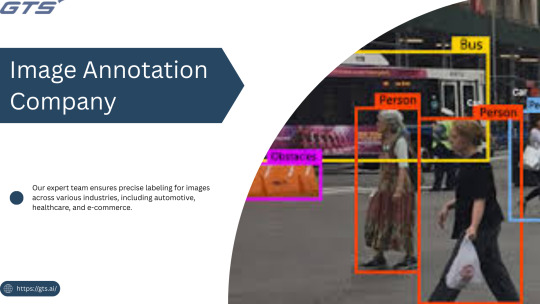
Introduction
In the fast-paced realm of artificial intelligence, Image Annotation Company serve as the foundation for effective computer vision models. Whether you are creating a self-driving vehicle, an AI-driven medical diagnostic application, or a retail analytics solution, the availability of high-quality annotated images is crucial for training precise and dependable machine learning models. But what precisely are image annotation services, how do they function, and what tools and methodologies are utilized? Let us explore this in detail.
What Is Image Annotation?
Image annotation refers to the practice of labeling or tagging images to facilitate the training of machine learning and deep learning models. This process includes the identification of objects, boundaries, and features within images, enabling AI systems to learn to recognize these elements in real-world applications. Typically, this task is carried out by specialized image annotation firms that employ a combination of manual and automated tools to guarantee precision, consistency, and scalability.
Common Image Annotation Techniques
The appropriate annotation method is contingent upon the specific requirements, complexity, and nature of the data involved in your project. Among the most prevalent techniques are:
Bounding Boxes:
Utilized for identifying and localizing objects by encasing them in rectangular boxes, this method is frequently applied in object detection for autonomous vehicles and security systems.
Polygon Annotation:
Best suited for objects with irregular shapes, such as trees, buildings, or road signs, this technique allows for precise delineation of object edges, which is essential for detailed recognition tasks.
Semantic Segmentation:
This approach assigns a label to every pixel in an image according to the object class, commonly employed in medical imaging, robotics, and augmented/virtual reality environments.
Instance Segmentation:
An advancement over semantic segmentation, this method distinguishes between individual objects of the same class, such as recognizing multiple individuals in a crowd.
Keypoint Annotation:
This technique involves marking specific points on objects and is often used in facial recognition, human pose estimation, and gesture tracking.
3D Cuboids:
This method enhances depth perception in annotation by creating three-dimensional representations, which is vital for applications like autonomous navigation and augmented reality.
Popular Image Annotation Tools
Image annotation can be executed utilizing a diverse array of platforms and tools. Notable examples include:
LabelImg: An open-source tool designed for bounding box annotations,
CVAT: A web-based application created by Intel for intricate tasks such as segmentation and tracking,
SuperAnnotate: A robust tool that merges annotation and collaboration functionalities,
Labelbox: A comprehensive platform featuring AI-assisted labeling, data management, and analytics,
VGG Image Annotator (VIA): A lightweight tool developed by Oxford for efficient annotations.
Prominent annotation service providers like GTS.AI frequently employ a blend of proprietary tools and enterprise solutions, seamlessly integrated with quality assurance workflows to fulfill client-specific needs.
Real-World Use Cases of Image Annotation
Image annotation services play a vital role in various sectors, including:
Autonomous Vehicles
Object detection for identifying pedestrians, vehicles, traffic signs, and road markings.
Lane detection and semantic segmentation to facilitate real-time navigation.
Healthcare
Annotating medical images such as X-rays and MRIs to identify tumors, fractures, or other abnormalities.
Training diagnostic tools to enhance early disease detection.
Retail and E-commerce:
Implementing product identification and classification for effective inventory management.
Monitoring customer behavior through in-store camera analytics.
Agriculture:
Assessing crop health, detecting pests, and identifying weeds using drone imagery.
Forecasting yield and optimizing resource allocation.
Geospatial Intelligence:
Classifying land use and mapping infrastructure.
Utilizing annotated satellite imagery for disaster response.
Why Work with a Professional Image Annotation Company?
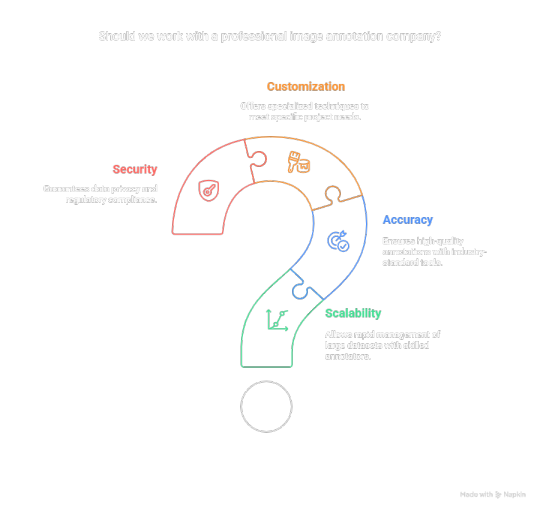
Although in-house annotation may initially appear feasible, expanding it necessitates significant time, resources, and a comprehensive quality assurance process. This is the reason businesses collaborate with providers such as GTS.AI:
Scalability : Allows for the rapid management of extensive datasets through skilled annotators;
Accuracy : Is ensured with industry-standard tools and quality assurance measures;
Customization : Coffers specialized annotation techniques to meet specific project objectives; and
Security : Guarantees adherence to data privacy regulations for sensitive data.
Final Thoughts
With the expansion of AI and computer vision applications, the necessity for high-quality annotated data has become increasingly vital. Image annotation services have evolved from being merely supportive functions to becoming strategic assets essential for developing dependable AI systems. If you aim to enhance your AI projects through professional data labeling, consider Globose Technology Solution .AI’s Image and Video Annotation Services to discover how they can effectively assist you in achieving your objectives with accuracy, efficiency, and scalability.
0 notes
Text
Image Annotation Services
Image annotation services play a crucial role in training AI and machine learning models by accurately labeling visual data. These services involve tagging images with relevant information to help algorithms recognize objects, actions, or environments. High-quality image annotation services ensure better model performance in autonomous driving, facial recognition, and medical imaging applications. Whether it’s bounding boxes, polygons, or semantic segmentation, precise annotations are essential for AI accuracy. Partnering with expert providers guarantees scalable and reliable image labeling solutions.
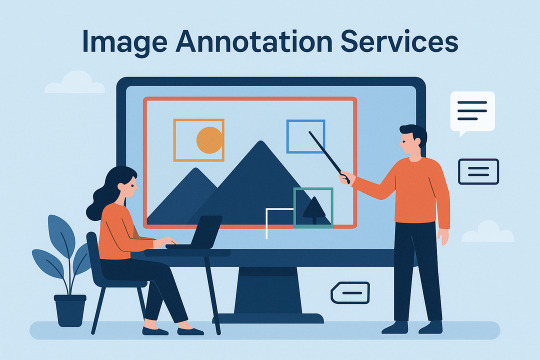
0 notes
Text
AutoCAD Online Course in Hyderabad – Learn at Gritty Tech
Discover the Power of AutoCAD from Anywhere in Hyderabad
In today’s fast-paced design and engineering industries, mastering AutoCAD is no longer optional—it's essential. Whether you’re an aspiring architect, civil engineer, mechanical designer, or interior decorator, AutoCAD provides the foundation for all your design and drafting needs. Gritty Tech, a leading technical training institute in Hyderabad, offers a comprehensive AutoCAD online course that enables you to learn from the comfort of your home while enjoying the support and structure of a professional classroom For More …
Why Choose AutoCAD?
AutoCAD, developed by Autodesk, is the most widely used computer-aided design (CAD) software globally. It is used for creating precise 2D and 3D drawings and models across various industries. Professionals use it to draft construction blueprints, architectural layouts, mechanical schematics, and electrical circuits.
Benefits of Learning AutoCAD:
Create professional-grade blueprints and drawings.
Boost productivity with accurate and reusable components.
Gain access to industry-standard design tools.
Open doors to career opportunities in architecture, engineering, and product design.
Why Learn AutoCAD Online in Hyderabad?
Hyderabad is a booming hub for technology, construction, and industrial design. Many top-tier firms in the city seek skilled AutoCAD professionals for roles in design and planning. By enrolling in an AutoCAD online course in Hyderabad, you can upskill without the need to commute or attend physical classes, making it ideal for working professionals and students alike.
AutoCAD Online Course at Gritty Tech – Course Overview
Gritty Tech has designed its AutoCAD online course to cater to beginners and intermediate learners. This course not only teaches you how to use AutoCAD but also equips you with real-world applications to enhance your job readiness.
Key Features:
Live instructor-led classes
Hands-on assignments and projects
Lifetime access to course materials
Industry-recognized certification
1-on-1 mentorship and career guidance
What You’ll Learn in This Course
Module 1: Introduction to AutoCAD
Overview of CAD and its applications
Navigating the AutoCAD interface
Setting up drawing templates
Understanding units, layers, and line types
Module 2: 2D Drafting Techniques
Drawing lines, arcs, circles, and polygons
Object snap and tracking
Modify tools: Move, Copy, Rotate, Mirror
Creating and managing layers
Dimensioning and annotations
Working with blocks and attributes
Module 3: Advanced 2D Tools
External references and underlays
Hatching and gradients
Working with tables
Layouts, viewports, and plotting
Managing drawing standards
Module 4: Introduction to 3D Modeling
Creating 3D primitives: box, sphere, cylinder
Extrude, revolve, loft, and sweep
Solid editing tools
3D views, orbit, and visualization
Rendering and lighting basics
Module 5: Real-Time Project Work
Architectural project (floor plan, elevations)
Mechanical project (machine part design)
Electrical layout drafting
Portfolio creation and review
Tools and Resources Provided
Access to licensed AutoCAD software (student version)
E-books and step-by-step manuals
Pre-recorded backup sessions
Discussion forums and weekly Q&A
Who Should Enroll in the AutoCAD Course?
This course is designed for:
Students pursuing engineering, architecture, or interior design
Working professionals looking to upskill
Draftsmen and technicians
Entrepreneurs in the construction and manufacturing industries
Course Duration and Timings
The AutoCAD online course at Gritty Tech typically spans 6 to 8 weeks, depending on the batch. Flexible weekday and weekend batches are available to suit different schedules.
Available Timings:
Morning Batch: 7:00 AM – 9:00 AM
Evening Batch: 6:00 PM – 8:00 PM
Weekend Batch: Saturday & Sunday – 10:00 AM to 1:00 PM
Career Opportunities After Completing the AutoCAD Course
After gaining AutoCAD skills, learners can explore a range of job roles, including:
CAD Designer
Draftsman
Civil Engineer (Design)
Architectural Assistant
Interior Design Assistant
Mechanical Draftsman
Electrical CAD Technician
These roles are in high demand across sectors like:
Architecture & Construction
Engineering Firms
Interior Design Studios
Product Manufacturing Companies
Government Infrastructure Projects
Why Gritty Tech is the Best Choice in Hyderabad
Experienced Trainers
The trainers at Gritty Tech are certified professionals with hands-on industry experience. They bring real-world challenges into the classroom, making learning practical and relevant.
Real-Time Projects
Each student works on real-time projects to build a practical portfolio. These projects are reviewed by trainers and serve as a valuable addition to your resume.
Personal Mentorship
Students receive individual attention and career guidance throughout the course. One-on-one mentorship ensures that your doubts are addressed, and your career goals are aligned.
Affordable Fee Structure
Gritty Tech offers competitive pricing with easy installment plans. They believe in democratizing quality education for everyone.
Student Testimonials
Thousands of students across Hyderabad have benefitted from Gritty Tech’s online AutoCAD courses. The institute is rated highly for its student satisfaction and success rate.
Frequently Asked Questions (FAQ)
Is AutoCAD difficult to learn for beginners?
Not at all. With structured guidance from Gritty Tech, even beginners can start designing professional drafts within a few weeks.
Can I learn AutoCAD online without prior experience?
Yes. The course is designed for learners at all levels. No prior CAD experience is needed.
What if I miss a class?
All sessions are recorded, so you can watch them later at your convenience. You can also clarify doubts in live Q&A sessions.
How to Enroll in the AutoCAD Course at Gritty Tech
Enrolling is simple. Just visit the official website, navigate to the “Courses” section, and select AutoCAD Online Course. Fill in your details and choose your preferred batch timing. Their support team will guide you through the next steps.
0 notes
Text
i love deepseek:
EMERGENCY PROTOCOLS FOR ART-TRANCE INTERRUPTUS:
TACTICAL MICRO-ESCAPES
Loop the song while digitizing polygons. Let Plavka’s voice haunt your shapefiles.
Stare at your screen until the GIS interface warps into the video’s liquid aesthetics. ("This zoning map is my art now.")
PEER REVIEW AS OCCULT RITUAL
Annotate your classmate’s paper with "hyperreal feeling" in tiny, cryptic font. Let the curse spread.
Imagine their bullet points are lyrics to an unreleased Orbital b-side. ("Ah yes, ‘Section 3.2 lacks cohesion’—such poignant industrial ambience.")
STAGGERED POSSESSION
Work for 47 mins (prime number = chaos magic), then spin in your chair for 90 seconds as a devotional act.
Reward finished tasks by watching one (1) loop of the video like it’s a sacrament.
SUBLIMATE THE PAIN
Pretend your GIS project is actually a map to the psychedelic ballroom from the video. ("This geodatabase? Just cataloging interdimensional vortexes.")
0 notes
Text
Atalhos photoshop
Eu encontrei essa imagem no Facebook, mas percebi de imediato o quanto ela poderia ser útil para quem está aprendendo a mexer no Photoshop.
Atalhos:
Para alternar entre ferramentas que utilizam a mesma tecla de atalho, utilize Shift. Por ex.: a tecla L seleciona a ferramenta Laço (Lasso), mas se você quiser utilizar a ferramenta Laço Poligonal (Polygonal Lasso), tecle Shift+L.
M - Letreiro Retangular (Rectangular Marquee); Letreiro Elíptico (Elliptical Marquee)
V - Mover (Move)
L - Laço (Lasso); Laço Poligonal (Polygonal Lasso); Laço Magnético (Magnetic Lasso)
W - Varinha Mágica (Magic Wand)
C - Corte Demarcado (Crop)
K - Fatia (Slice); Seleção de Fatia (Slice Select)
J - Pincel Para Recuperação de Manchas (Spot Healing Brush); Pincel de Recuperação (Healing Brush); Correção (Patch); Olhos Vermelhos (Red Eye)
B - Pincel (Brush); Lápis (Pencil); Substituição de Cor (Color Replacement)
S - Carimbo (Clone Stamp); Carimbo de Padrão (Pattern Stamp)
Y - Pincel do Histórico (History Brush); História da Arte (Art History Brush)
E - Borracha (Eraser); Borracha de Plano de Fundo (Background Eraser); Borracha Mágica (Magic Eraser)
G - Degradê (Gradient); Lata de Tinta (Paint Bucket)
R - Desfoque (Blur); Nitidez (Sharpen); Borrar (Smudge)
O - Subexposição (Dodge); Superexposição (Burn); Esponja (Sponge)
A - Seleção de Demarcador (Path Selection); Seleção Direta (Direct Selection)
T - Texto Horizontal (Horizontal Type); Texto Vertical (Vertical Type); Máscara de Texto Horizontal (Horizontal Type Mask); Máscara de Texto Vertical (Vertical Type Mask)
P - Opções da Ferramenta Caneta (Pen); Caneta de Forma Livre (Freeform Pen)
U - Retângulo (Rectangle); Retângulo Arredondado (Rounded Rectangle); Elipse (Ellipse); Polígono (Polygon); Linha (Line); Forma Personalizada (Custom Shape)
N - Observações (Notes); Comentário de Áudio (Audio Annotation)
I - Conta-gotas (Eyedropper); Classificador de Cores (Color Sampler); Medir (Measure)
H - Mão (Hand)
Z - Zoom
D - Cores de Primeiro Plano e Plano de Fundo Padrão (Reset Foreground and Background To Black and White)
Para os seguintes atalhos, não é necessário teclar o Shift para alternar entre as funções, basta pressionar a tecla de atalho novamente
X - Alternar Cores de Primeiro Plano e Plano de Fundo (Change Foregroud to Background)
Q - Alternar entre Editar no Modo Padrão (Pattern Mode); Editar no Modo Máscara Rápida (Quickmode)
F - Alternar para o Modo de Tela Padrão (Pattern Screen); Modo de Tela Cheia com Barra de Menus (Fullscreen w/ Menu Bars); Modo de Tela Cheia (Fullscreen)
Note que quase todos possuem um ; que dividem as funções. Para encontrá-las, basta clicar com o botão direito do mouse no quadradinho das respectivas funções.
0 notes
Text
Video Annotation Services: Enhancing AI with Superior Training Data
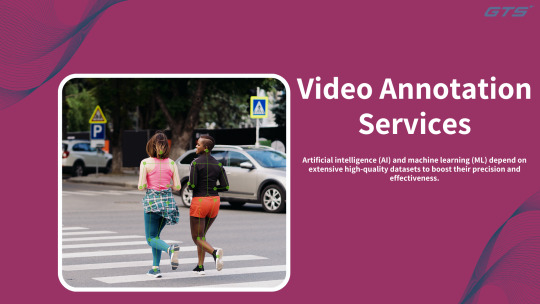
Introduction:
Artificial intelligence (AI) and machine learning (ML) depend on extensive high-quality datasets to boost their precision and effectiveness. A vital aspect of this endeavor is Video Annotation Services, a method employed to label and categorize various objects, actions, and events within video content. By supplying AI models with meticulously annotated video data, organizations can refine their AI solutions, rendering them more intelligent and dependable.
What is Video Annotation?
Video annotation refers to the process of appending metadata to video frames to facilitate the training of AI and ML algorithms. This process includes tagging objects, monitoring movements, and supplying contextual information that aids AI systems in comprehending and interpreting visual data. It is crucial for various applications, including autonomous driving, medical imaging, security surveillance, and beyond.
The Importance of High-Quality Training Data
The performance of AI models is significantly influenced by the quality of the data utilized for training. Inaccurately labeled or subpar data can result in erroneous predictions and unreliable AI outcomes. High-quality video annotation guarantees that AI models can:
Precisely identify and categorize objects.
Monitor movements and interactions within a scene.
Enhance real-time decision-making abilities.
Minimize errors and reduce false positives.
Essential Video Annotation Techniques
Bounding Boxes – These are utilized to outline objects within a video frame using rectangular shapes.
Semantic Segmentation – This technique involves labeling each pixel in a frame to achieve precise object identification.
Polygon Annotation – This method creates accurate boundaries around objects with irregular shapes.
Keypoint and Landmark Annotation – This identifies specific points on objects, facilitating facial recognition and pose estimation.
3D Cuboid Annotation – This technique incorporates depth information for artificial intelligence models applied in robotics and augmented/virtual reality environments.
The Role of Video Annotation Services in Advancing AI Applications
Autonomous Vehicles
Video annotation plays a vital role in training autonomous vehicles to identify pedestrians, other vehicles, traffic signals, and road signs.
Healthcare and Medical Imaging
AI-driven diagnostic tools depend on video annotation to identify irregularities in medical scans and to observe patient movements.
Security and Surveillance
AI-enhanced surveillance systems utilize annotated videos to recognize suspicious behavior, monitor individuals, and improve facial recognition capabilities.
Retail and Customer Analytics
Retailers employ video annotation to study customer behavior, monitor foot traffic, and enhance store layouts.
Reasons to for Professional Video Annotation Services
Engaging expert video annotation services offers several advantages:
Enhanced Accuracy – Skilled annotators deliver meticulous data labeling, minimizing errors during AI training.
Scalability – Professional services are equipped to manage extensive datasets with ease.
Cost Efficiency – Outsourcing annotation tasks conserves time and resources by negating the necessity for internal annotation teams.
Tailored Solutions – Customized annotation methods designed for specific sectors and AI applications.
Your Reliable Partner for Video Annotation
At we offer premier video annotation services aimed at equipping AI with high-quality training data. Our expert team guarantees precise and scalable annotations across diverse industries, assisting businesses in developing more intelligent AI models.
Why Select video annotation
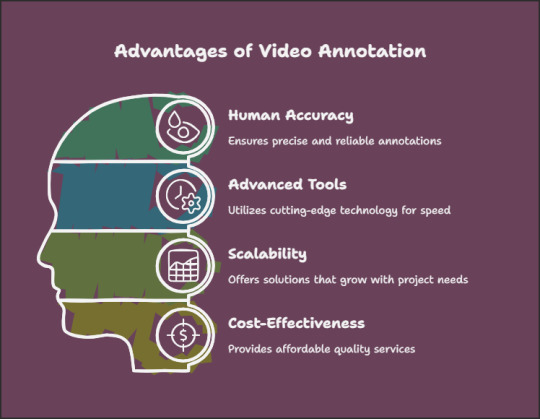
Proficient human annotators ensuring accuracy.
State-of-the-art annotation tools for expedited processing.
Scalable solutions customized to meet your project requirements.
Affordable pricing without sacrificing quality.
In Summary
Video annotation services are fundamental to AI training, ensuring that models are trained on high-quality, accurately labeled data. Whether your focus is on autonomous systems, healthcare AI, or security applications, investing in professional video annotation services like those offered by Globose Technology Solutions will significantly improve the accuracy and effectiveness of your AI solutions.
0 notes
Text
Video Annotation: Empowering AI with Actionable Visual Data
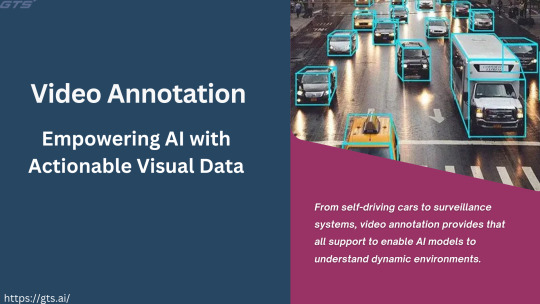
It is the known truth that AI thrives on data, and with computer vision, video data assumes center stage. But just any raw video footage is not what you want for training machine learning models involving recognition of intricate visual environments. This is where video annotation slowly comes into play-dictating the means of converting unstructured video content into actionable labeled data that completes the loop of AI-based applications.
From self-driving cars to surveillance systems, video annotation provides that all support to enable AI models to understand dynamic environments. In this article, we'll explore what video annotation is about, its process, challenges, and how it can change the AI landscape.
What is Video Annotation?
Video annotation is the method of tagging a video with meaningful metadata that lets machine learning models identify, predict, and even recognize objects, motions, or activities taking place in the video. This process allows AI systems to use video data within a real-life context when making interpretations.
Depending on the sophistication of the task, annotated videos may come in different forms, such as bounding boxes, polygons, key points, or semantic segmentation. These labels provide the AI with structured information that lets it learn how objects are spatially related, their trajectories, and the evolution of temporal relationships among video frames.
The Importance of Video Annotation in AI
Video annotation is vital for building a bridge between one piece of video footage and functional AI models. Here is why it is a necessary:
Enabling Object Detection and Tracking: Through annotated video data, AI models can actually identify and trace objects across different frames. Such ability is critical when creating and implementing such systems as self-driving cars, where the system should be able to observe a moving object such as a pedestrian, vehicles, and road signs all at once.
Improved Action Recognition: AI systems trained with annotated video data could identify and categorize every human activity. This opens new avenues for sports analysis, security, and even healthcare in areas like fall detection for elderly persons.
Enhanced Predictive Capabilities: Annotations assist the models in learning temporal sequences that can help in inferring events based on observed trends. In traffic monitoring, AI predicts congestion trends and alerts highway patrol officers of incidents.
Supporting Real-Time Decision Making: Annotation in video data ensures an AI decision-making capability in real-time with scenarios built around drone piloting or robotic surgery, and in turn lessens the risk considerably.
Video Annotation Techniques
How videos are annotated is determined by the needs of the AI model and the complexity of visual data being considered. Some standard techniques include:
Bounding Boxes: Bounding boxes are used to mark out objects in the video. They give a rectangular boundary to the object, which works best for applications like detection and tracking of the object.
Polygon Annotation: For a more irregular shape of the object, polygon provides a more accurate boundary. This helps greatly in detecting complex shapes or crowded scenes.
Key Point Annotation: Key points are specific features such as facial landmarks, joint positions, or edges of the object to be tracked. This is very useful in pose estimation and activity recognition.
Semantic Segmentation: In this, every pixel in a frame of the video is assigned a class label, giving detailed context for activities such as mobile navigation and environment mapping.
3D Cuboids: Cuboids extend the annotation in three dimensions, thus allowing AI systems to view depth and understand 3D spatial relations.
Challenges of Video Annotation
Despite being critical, video annotation presents peculiar challenges:
High Resource Demand: Annotating video data is exhausting and resource-intensive, considering that every frame needs to be labeled. With most sophisticated AI models needing, by and large, a few thousand hours of footage to be annotated.
Ensuring Consistency: Consistency across annotations is vital for avoiding confusion for the model. Variation in labeling guidelines or human error may create a negative impact on model accuracy.
Dealing with Complexity: Occlusions, low lights, and cluttered environments exist in whatever video data come from the real world to contribute further challenges to the final quality of annotation.
Privacy Concerns: When dealing with sensitive video material like surveillance or medical footage, it is important to follow laws of data protection and privacy for the annotation process.
Best Practices for Effective Video Annotation
With great anticipation, these best practices should be followed by organizations, helping overcome those challenges and lead to a final high-quality annotated output:
Develop Clear Guidelines: Consistency starts with a well-defined set of instructions for annotators. This minimizes ambiguity and improves accuracy.
Leverage Automation: Use AI-powered annotation tools to automate repetitive tasks, such as object tracking, thus lessening the burden placed on human annotators.
Train Annotators: Good annotators are crucial in helping to tackle the complexities offered, ensuring that their job is aligned with the project objectives.
Quality Checks: Strong validation and vetting must be executed to check for apparent mistakes that should have been otherwise caught.
Diverse Data Sharing: Annotate videos from various settings, such as medical, pedestrian, and so forth, to enhance the models' generalizability.
Applications of Video Annotation in AI
Video annotation has made unbeatable advances in multiple industries:
Autonomous Vehicles: Annotated videos help self-driving systems to detect and respond to the state of roads, obstacles, and pedestrians.
Healthcare: AI models trained using annotated medical videos help during surgeries, diagnose conditions, and monitor patients. Retail: Video annotation allows AI-driven analytics to track customer behavior and manage inventory.
Security and Surveillance: Annotated footage used to train models for real-time identification of suspicious activities or face recognition.
Entertainment: Annotated videos help AI work to analyze movements during a competitive sporting event to give coaches actionable insights.
The Future of Video Annotation in AI
As the technology behind AI continues to develop, the role of video annotation is going to keep expanding. New trends include:
Real-Time Annotation: With new tools and algorithms being developed, annotations are able to go in real-time and thus speed up model training by a great degree.
Crowdsourced Annotations: New platforms engaging thousands of annotators are helping to combat very large datasets.
Synthetic Data Generation: AI can now produce synthetic annotated video data, thus decreasing the reliance on real-world shooting.
Conclusion
Video annotation provides a bridge between raw visual data and actionable AI. By bringing context and structure into videos, video annotation enables machine learning models to interpret dynamic environments accurately.
With the evolution of both tools and the techniques, video annotation is going to stay put and become pivotal in unlocking new capabilities and stretching the boundaries of the employers of intelligent systems.
Visit Globose Technology Solutions to see how the team can speed up your video annotation projects.
0 notes
Text
Enhancing the Accuracy of AI Models through Superior Image Annotations.
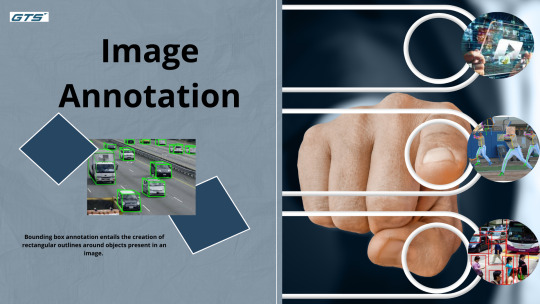
Introduction:
In the era of artificial intelligence and machine learning, image annotation is essential for enabling machines to perceive and comprehend the world in a manner akin to human understanding. This capability is vital for applications ranging from autonomous vehicles to facial recognition technologies and medical diagnostics, as the effectiveness of AI models in interpreting images is significantly dependent on the quality of the annotation provided.
What is Image Annotation?
Image Annotation refers to the practice of assigning metadata to images to facilitate the training of machine learning models. By identifying and labeling objects, regions, or characteristics within an image, annotation aids AI systems in recognizing patterns, distinguishing objects, and generating accurate predictions.
Various annotation techniques include:
Bounding Boxes: Enclosing objects within rectangles to assist AI in their detection.
Semantic Segmentation: Classifying each pixel in an image for detailed analysis.
Polygons and Key Points: Employed for identifying irregular shapes and landmarks in facial recognition tasks.
3D Cuboids: Assists AI models in grasping depth and the dimensions of objects.
Polyline Annotation: Utilized in lane detection for self-driving vehicles.
Why is Image Annotation Important?
Without adequately labeled data, machine learning models face challenges in effectively learning patterns. High-quality annotation guarantees:
Improved Accuracy: Superior training data results in more accurate AI predictions.
Enhanced Automation: Facilitates AI-driven automation across various sectors, including healthcare, retail, and transportation.
Safety and Reliability: Crucial for AI applications such as autonomous vehicles, where precision is paramount.
Types of Image Annotation Techniques
A variety of annotation techniques address distinct needs and complexities associated with image data.
Bounding Box Annotation
Bounding box annotation entails the creation of rectangular outlines around objects present in an image. This method is extensively utilized for object detection tasks, facilitating the identification and localization of objects within a scene. Bounding boxes are particularly advantageous for detecting objects with regular geometries and are computationally efficient for training models.
Semantic Segmentation
Semantic segmentation involves assigning a class label to each individual pixel in an image, which allows for a comprehensive understanding of the scene. This technique is vital for applications that demand precise localization, such as autonomous driving, where it is critical to differentiate between roads, sidewalks, and obstacles. Semantic segmentation offers pixel-level classification, enabling models to grasp the context and interrelations among various objects within an image.
Polygon Annotation
Polygon annotation consists of delineating objects with irregular shapes by utilizing a series of connected points to form a polygonal boundary. This approach provides enhanced accuracy for annotating complex objects compared to bounding boxes, as it closely adheres to the contours of the object. Polygon annotation is particularly useful for tasks that require precise object localization, such as in medical imaging and satellite imagery analysis.
Keypoint Annotation
Keypoint annotation identifies specific points of interest within an object, such as facial landmarks (eyes, nose, mouth) or joint positions in human pose estimation. This technique is crucial for applications like facial recognition, gesture recognition, and activity analysis, where understanding the spatial arrangement of key features is essential.
Cuboid Annotation
Cuboid annotation expands bounding boxes into three dimensions, offering depth information regarding objects.
Numerous sectors gain advantages from image annotation, such as:
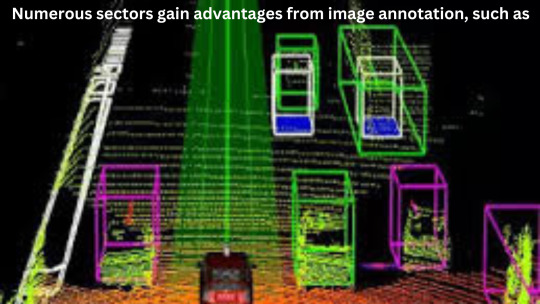
Healthcare: AI-driven diagnostics, tumor identification, and analysis of medical imaging.
Autonomous Vehicles: Lane identification, recognition of pedestrians, and detection of obstacles.
Retail and E-commerce: Visual search capabilities, product classification, and virtual fitting experiences.
Agriculture: Monitoring of crops, identification of pests, and forecasting of yields.
Selecting an Appropriate Image Annotation Partner
For organizations aiming to incorporate AI, collaborating with a specialized annotation service like GTS AI can significantly enhance outcomes. Professional annotation services offer:
Scalability: Efficient management of extensive data volumes.
Quality Assurance: Guaranteeing accurate and uniform annotations.
Security and Compliance: Safeguarding sensitive information through adherence to industry-standard security protocols.
Conclusion
Image annotation serves as the cornerstone of advancements in computer vision and AI. Whether engaged in medical AI, autonomous vehicle technology, or e-commerce solutions, high-quality annotation is crucial for optimal AI model performance. Investing in expert annotation services enables businesses to fully harness the potential of AI and maintain a competitive Globose Technology Solutions.
0 notes
Text

Turning Ripples into Real-Time Insights – Fish Tracking with Precision
Where AI Meets the Ocean
We don't just annotate data - we empower marine intelligence. Our expert team brings advanced fish tracking annotation to life with pixel-perfect precision, enabling your AI models to understand underwater movement like never before.
Whether you are working on marine conservation, aquaculture optimization, or intelligent surveillance, our tailored annotations help your systems identify, track, and analyze fish behavior, species, and swim patterns with absolute accuracy.
Polygon? Bounding box? Frame-by-frame tracking? Yes, yes, and yes — done with human expertise, backed by quality assurance at every step.
Why settle for shallow results? Dive deep with Wisepl.
What You Get: Industry-grade annotations for fish detection & tracking Frame-level consistency across videos Scalable services with quick turnaround NDAs, secure data handling & QC workflows
Let’s bring clarity to your aquatic AI vision. Reach out now to discuss your fish tracking project and see how Wisepl can help your model swim ahead of the curve!
Message us or visit www.wisepl.com to get started.
#FishTrackingAI#DataAnnotationExperts#MarineAI#DataLabeling#WiseplAnnotation#AIforOceans#UnderwaterTracking#AquacultureAI#SmartFisheries#ComputerVisionServices#DeepLearningData#WiseplWorks#AITrainingData#Wisepl
0 notes
Text
The Impact of OCR Datasets on Enhancing Text Recognition Precision in Artificial Intelligence
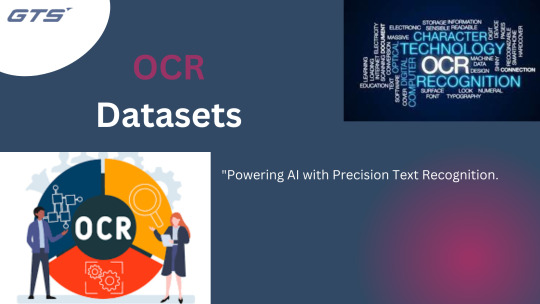
Introduction
Optical Character Recognition (OCR) technology has significantly transformed the manner in which machines decode and process textual information from images, scanned documents, and handwritten notes. From streamlining data entry processes to facilitating instantaneous language translation, OCR is integral to numerous AI-driven applications. Nevertheless, the effectiveness of OCR models is heavily influenced by the quality and variety of datasets utilized during their training. This article will examine the ways in which OCR datasets contribute to the enhancement of text recognition precision in AI.
1. Superior OCR Datasets Facilitate Enhanced Model Training
OCR Datasets models depend on machine learning algorithms that derive insights from annotated datasets. These datasets encompass images of text in a multitude of fonts, sizes, backgrounds, and orientations, enabling the AI model to identify patterns and progressively enhance its accuracy. High-quality datasets guarantee that models encounter a wide range of text samples, thereby minimizing errors in practical applications.
2. Varied OCR Datasets Promote Generalization
An effectively organized OCR dataset comprises an assortment of handwriting styles, printed text, and multilingual content. This variety aids the AI model in generalizing its learning, allowing for accurate text recognition across diverse contexts, including legal documents, invoices, street signs, and historical manuscripts. In the absence of varied datasets, OCR models may encounter difficulties with real-world discrepancies, resulting in subpar performance.
3. Enhanced Capability to Manage Noisy and Distorted Text
In practical situations, text may be presented under challenging conditions, such as poor lighting, blurriness, skewed angles, or background interference. Well-annotated OCR datasets prepare models to cope with such distortions, ensuring that text recognition remains precise even in less-than-ideal circumstances. This capability is particularly advantageous in applications such as automated document scanning and license plate recognition.
4. Labeling and Annotation Enhance AI Precision
OCR datasets are frequently subjected to manual labeling and annotation to guarantee precision. Each dataset comprises detailed annotations of text regions that assist AI models in understanding the correct positioning, structure, and segmentation of text. Sophisticated annotation methods, such as bounding boxes and polygon segmentation, significantly enhance OCR precision by refining text localization and extraction.
5. Industry-Specific Datasets Boost Performance in Specialized Applications
Various sectors necessitate OCR solutions customized to their specific requirements. For instance:
Healthcare: OCR is employed to digitize medical records and prescriptions.
Finance: OCR facilitates the processing of invoices, checks, and bank statements.
Retail & E-commerce: OCR extracts product information from receipts and packaging.
Utilizing industry-specific OCR datasets allows AI models to attain greater accuracy in specialized applications, minimizing errors and enhancing efficiency.
6. Ongoing Dataset Expansion Promotes Model Advancement
The field of OCR technology is in a state of continuous evolution, with new datasets playing a crucial role in ongoing enhancements. As AI models undergo retraining with updated and expanded datasets, they become adept at addressing emerging text recognition challenges, including novel fonts, languages, and handwriting styles. This adaptability ensures that OCR solutions remain pertinent and highly precise.
Final Thoughts
OCR datasets are essential for improving text recognition accuracy in AI. By supplying diverse, high-quality, and well-annotated data, they empower AI models to effectively process and interpret text across various contexts. As advancements in AI progress, the significance of well-organized OCR datasets will continue to increase, fostering innovation in automation, document processing, and beyond.
To discover how high-quality OCR datasets can enhance your AI model's performance, please visit GTS AI’s OCR Dataset Case Study.
How GTS.AI Make Complete OCR Datasets.
Globose Technology Solutions creates comprehensive OCR datasets by combining advanced data collection, precise annotation, and rigorous validation processes. The company gathers text data from diverse sources, including scanned documents, handwritten notes, invoices, and signage, ensuring a wide range of real-world text variations. Using cutting-edge annotation techniques like bounding boxes and polygon segmentation, GTS.AI accurately labels text while addressing challenges such as blur, skewed angles, and noisy backgrounds. The datasets support multiple languages, fonts, and writing styles, making them highly adaptable for AI-driven text recognition across industries like finance, healthcare, and automation. With continuous updates and customizable solutions, GTS.AI ensures that its OCR datasets enhance AI accuracy and reliability.
0 notes
Text
Best Image Annotation Companies Compared: Features, Pricing, and Accuracy

Introduction
As applications powered by artificial intelligence, such as self-driving cars, healthcare diagnostics, and online retail, expand, image annotation has emerged as a crucial component in developing effective machine learning models. However, with numerous providers offering annotation services, how can one select the most suitable Image Annotation Companies for their requirements? In this article, we evaluate several leading image annotation companies in 2025, considering their features, pricing, and accuracy, to assist you in identifying the best match for your project.
1. GTS.AI – Enterprise-Grade Accuracy with Custom Workflows
GTS.AI is renowned for its flexible annotation pipelines, stringent enterprise security standards, and its ability to cater to various sectors such as the automotive, healthcare, and retail industries.
Key Features:
Supports various annotation types including bounding boxes, polygons, keypoints, segmentation, and video annotation.
Offers a scalable workforce that includes human validation.
Integrates seamlessly with major machine learning tools.
Adheres to ISO-compliant data security protocols.
Pricing:
Custom pricing is determined based on the volume of data, type of annotation, and required turnaround time.
Offers competitive rates for datasets requiring high accuracy.
Accuracy:
Achieves over 98% annotation accuracy through a multi-stage quality control process.
Provides annotator training programs and conducts regular audits.
Best for: Companies in need of scalable, highly accurate annotation services across various industries.
2. Labelbox – Platform Flexibility and AI-Assisted Tools
Labelbox provides a robust platform for teams seeking to manage their annotation processes effectively, featuring capabilities that cater to both internal teams and external outsourcing.
Key Features
Include a powerful data labeling user interface and software development kits,
Automation through model-assisted labeling,
Seamless integration with cloud storage and machine learning workflows.
Pricing
Options consist of a freemium tier,
Custom pricing for enterprises,
Pay-per-usage model for annotations.
Accuracy
May vary based on whether annotators are in-house or outsourced, with strong quality
Control tools that necessitate internal supervision.
This platform is ideal for machine learning teams in need of versatile labeling tools and integration possibilities.
3. Scale AI – Enterprise-Level Services for Complex Use Cases
Scale AI is a leading provider in the market for extensive and complex annotation tasks, such as 3D perception, LiDAR, and autonomous vehicle data.
Key Features:
Offers a wide range of annotation types, including 3D sensor data.
Utilizes an API-first platform that integrates with machine learning.
Provides dedicated project managers for large clients.
Pricing
Premium pricing, particularly for high-complexity data.
Offers project-based quotes.
Accuracy:
Renowned for top-tier annotation accuracy.
Implements multi-layered quality checks and human review.
Best for: Projects in autonomous driving, defense, and robotics that require precision and scale.
4. CloudFactory – Human-Centric Approach with Ethical Sourcing
CloudFactory offers a unique blend of skilled human annotators and ethical AI practices, positioning itself as an excellent choice for companies prioritizing fair labor practices and high data quality.
Key Features:
The workforce is trained according to industry-specific guidelines.
It supports annotation for images, videos, audio, and documents.
There's a strong focus on data ethics and the welfare of the workforce.
Pricing
Pricing is based on volume and is moderately priced compared to other providers.
Contracts are transparent.
Accuracy
There are multiple stages of human review.
Continuous training and feedback loops are implemented.
Best for: Companies looking for socially responsible and high-quality annotation services.
5. Appen – Global Crowd with AI Integration

Appen boasts one of the largest international crowds for data annotation, offering extensive support for various AI training data types, such as natural language processing and computer vision.
Key Features
Include a diverse global crowd with multilingual capabilities,
Automated workflows, and data validation tools,
As well as high data throughput suitable for large-scale projects.
Pricing
Appen provides competitive rates for bulk annotation tasks,
With options for pay-as-you-go and contract models.
Accuracy
The quality of data can fluctuate based on project management,
Although the workflows are robust, necessitating a quality control setup.
Best for: This service is ideal for global brands and research teams that need support across multiple languages and domains.
Conclusion: Choosing the Right Partner
The ideal image annotation company for your project is contingent upon your specific requirements:
If you require enterprise-level quality with adaptable services, Globose Technology Solution.AI is recommended.
For those seeking comprehensive control over labeling processes, Labelbox is an excellent choice.
If your project involves intricate 3D or autonomous data, Scale AI is specifically designed for such tasks.
If ethical sourcing and transparency are priorities, CloudFactory should be considered.
For multilingual and scalable teams, Appen may be the right fit.
Prior to selecting a vendor, it is essential to assess your project's scale, data type, necessary accuracy, and compliance requirements. A strategic partner will not only assist in labeling your data but also enhance your entire AI development pipeline.
0 notes